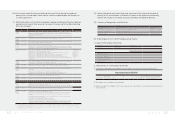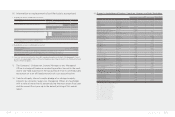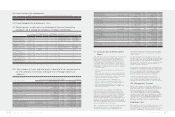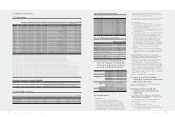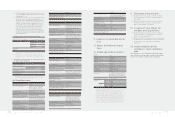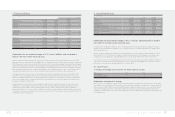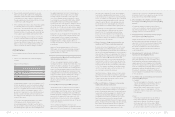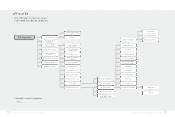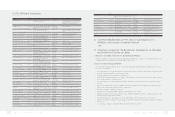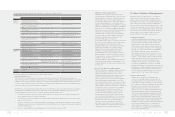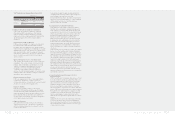HTC 2010 Annual Report Download - page 42
Download and view the complete annual report
Please find page 42 of the 2010 HTC annual report below. You can navigate through the pages in the report by either clicking on the pages listed below, or by using the keyword search tool below to find specific information within the annual report.
82 2 0 1 0 H T C A N N U A L R E P O R T 83
Financial Status, Operating Resul ts And Risk Management
(2) Cash flow analysis for the coming year
Unit:NT$ thousands
Beginning cash
balance
Projected whole-year cash flow
from operating activities
Projected whole-year cash
outflow
Projected cash surplus
(deficit) amount
Remedial measures for projected cash deficit
Investment plan Financial management plan
74,462,861 69,940,040 41,848,662 102,554,239 - -
Remedial measures for projected cash deficit: Not Applicable
IV. The Effect On Financial Operations Of Material Capital
Expenditures During The Most Recent Fiscal Year
(1) Review and analysis of material capital expenditures and funding sources
1. Material capital expenditure and funding sources
Unit:NT$ thousands
Planned items
Actual or projected
sources of capital
Actual or projected
date of completion Total capital needed (as of FY2011)
Actual or projected capital utilization
2009 2010 2011
Purchase and Installation of
Equipment / Facilities
working capital 2009~2011 8,165,429 490,166 3,289,848 4,385,416
Plant/Building Construction working capital 2009~2011 11,084,544 1,260,347 1,941,918 7,882,279
Factors Favorable to HTC Growth
1.
Partnerships with Industry Leaders Help HTC Drive
Industry Trends
HTC has always developed smartphone products in close
cooperation with industry leaders such as Microsoft,
Qualcomm and Google as well as the world's leading
telecommunications service providers. Examples include
HTC's launch of the world's first Windows Mobile
smartphone and first Android smartphone. Our strong
partnerships deliver greater choice to consumers while
continuing to drive industry innovation.
2. Long-term Cooperative Relationships with Telecom
Providers Keep HTC Abreast of Consumer Demand
HTC promotes products directly to mass-market
consumers via long-term, unique relationships with the
world's largest telecommunications service providers that
include the four big mobile operators in the United States,
five major operators in Europe and several fast growing
carriers in Asia. These relationships not only keep HTC
abreast of user demand but also allow HTC to better tailor
its products and services to the needs of each carrier
partner.
3. Diverse and growing universe of mobile digital
services drives smartphone market penetration
New mobile phone operating systems such as iOS and
Android, which permit easy app store downloading of
social networking, shopping, travel, game and other
software, are attracting even more consumers to the
ranks of smartphone users. Market analysts expect
the coming several years to be a period of particularly
strong smartphone sector growth, and we anticipate
telecom service providers' rollout of 3G/4G mobile
Internet networks to stimulate growth even further. These
developments should all impact positively on HTC business
growth prospects.
4. Instilling a positive corporate culture enhances
organizational flexibility and responsiveness
HTC promotes a unique corporate culture that is designed to instill
passion for innovation and commitment to the highest standards.
Our lack of barriers between departments promotes synergy
and dynamism even further. HTC's highly ecient operations
have been armed by numerous international quality standards
including ISO-9001, ISO-14001, ISO-14064-1, TL-9000, and
OHSAS 18001. Outstanding in-house research and development
capabilities give HTC the competitive edge to reach the market
first with many industry leading innovations and features.
5. Comprehensive domestic industry base supports
current and future growth needs
Active government and private sector eorts to grow the
domestic high tech sector in recent decades have given Taiwan a
strong foundation of skilled researchers and technicians. Taiwan
is further benefiting from increasingly coherent industry supply
and support systems and industry clustering eects. In addition
to making it easier for us to recruit and retain personnel, these
developments increasingly allow us to cooperate with domestic
and international suppliers in order to lower purchase costs and
respond even faster to industry trends and changes in market
demand.
Factors Adverse to the Achievement
of HTC Growth Goals and Relevant
Countermeasures
Many current and potential competitors are now active in
the smartphone market looking to benefit from current rapid
growth in worldwide demand. Competition should continue
to intensify as the smartphone user base grows, smartphone
functions and features increase, and smartphone model
lifecycles shorten. The following outlines HTC measures
designed to respond to such challenges.
1. We work actively to establish HTC brand value, enhance
global brand recognition and preference, and leverage
eective brand management activities and product
promotions to establish the HTC brand as consumers'
"first choice" in smartphones.
2. We emphasize innovative to maintain a leading
competitive edge. Product dierentiation and innovations
in user experience allow us to develop a wide range
of products tailored to meet diverse consumer needs.
Launched in 2009, the proprietary HTC Sense interface is
the result of extensive research and study in interpersonal
communications. HTC Sense is designed with customer at
the center to make mobile phones more intuitive and easy
to use.
3. We enhance product design, mass production, technical
support, distribution, and after-sales services for our
customers in order to strengthen strategic alliances with
global industry leaders and remain aligned with industry
trends and developments.
4. We regularly upgrade our materials requirement planning
(MRP) system to improve our ability to manage material
inventories and anticipate future demand in order to lower
inventory costs and reduce inventory devaluation risks.
We continue to build and diversify supplier relationships
to enhance supply stability. Our objectives are consistent
and uninterrupted supply of all materials and a highly
competitive cost structure.
2. Anticipated Benefits
(1) New Plant/Building Construction
The new Taoyuan Headquarters campus, Taipei
headquarters building and Kangqiao production facility
in Shanghai are essential to expanding production and
providing HTC employees with an appropriate working
environment.
(2) New Equipment / Facilities
Replacement / upgrade of equipment and facilities is
critical to enhancing productivity and meeting rising
market demand.
V. Investment Diversification In
Recent Years
Focused on its core business, HTC uses investment or merger
strategies to further its competitive advantages in product
development / design, sales and marketing, and long-term growth.
Such investments are intended to enhance product quality, product
value, user experience, customer service, cost structure, and
business eectiveness. The focus of future HTC investment activities
will be mobile content, communications, mobile and information
security, location-based services, entertainment and user interface /
experience innovation.
HTC and its aliates opened a number of subsidiaries in 2010 to bring
the group closer to key markets and customers. These subsidiaries,
including HTC South Eastern Europe Limited Liability Company, HTC
FRANCE CORPORATION, HTC Nordic ApS, HTC Germany GmbH, HTC
Iberia, S.L., and HTC Poland sp. z o.o., will be responsible for market
development, product repair and after-sales services. Strategic
acquisition of Abaxia SAS and BLRSoft and the establishment of HTC
America Innovation, Inc. are expected to strengthen HTC capabilities
in product design and software application development. HTC also
invested in China-based mobile security solutions provider NetQin
and Shanghai Gsuo Information Technology during 2010 and in online
video company Saron Digital, online game company OnLive, and
China-based mobile financial solutions provider Shanghai F-road
Commerce Service in early 2011.
HTC founded HTC America Holding, Inc. to streamline its overall
investment structure. HTC, as the parent company, recognized NT$1.5
billion gain on equity-method investments in 2010. The increase is
primarily due to growth in subsidiary profits including investment
gain of NT$700 million for HTC Electronics (Shanghai) Co., Ltd.
and NT$400 million for HTC America, Inc. Going forward, HTC
will continue to focus investments on enhancing user experience,
growing sales and improving mobile digital service applications as
well as integrating technologies gained through investments into HTC
products.
VI. Competitive Advantages,
Business Growth and
Assessment of Risks
(1) Potential Factors That May
Influence HTC's Competitiveness/
Business Growth and Related
Countermeasures
Critical competitive factors in HTC's industry include: 1) product R&D
and innovation capabilities, 2) strategic partnerships with industry
leaders and 3) accurate grasp of market trends. The following
assesses HTC's competitiveness in terms of factors deemed to
support and detract from HTC achieving its business goals.


